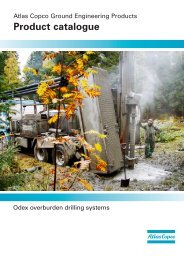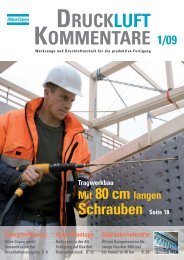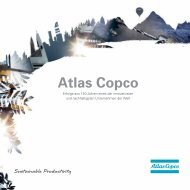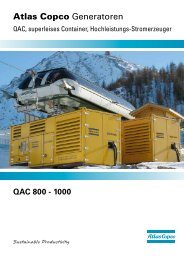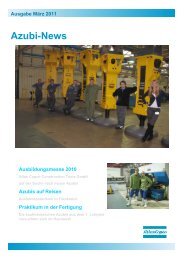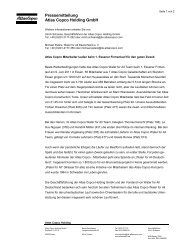Industrial Power Tools 2010-11 - Atlas Copco
Industrial Power Tools 2010-11 - Atlas Copco
Industrial Power Tools 2010-11 - Atlas Copco
You also want an ePaper? Increase the reach of your titles
YUMPU automatically turns print PDFs into web optimized ePapers that Google loves.
10<br />
Your guide to the catalogue<br />
Accessories included<br />
Under this heading a specification is<br />
given for each type of tool and of the<br />
parts (nipples, keys, guards, etc.) supplied<br />
with the tool. Instructions and a<br />
list of spare parts are always included<br />
in the package.<br />
Optional accessories<br />
Here you will find the specifications<br />
for most of the accessories. They are<br />
dependent on the job the tool is to be<br />
used for and have to be ordered separately.<br />
Air consumption<br />
The air consumption of the tools is<br />
stated in litres per second, l/s, and<br />
relates to free air, i.e., the compressed<br />
air expanded to atmospheric pressure.<br />
Unless otherwise stated, the figures<br />
are valid at a working pressure of 6.3<br />
bar and indicate the maximum air consumption.<br />
Maximum air consumption is valid<br />
for the tool without a speed governor<br />
when idling, i.e., when the tool is running<br />
at no load. A tool with a speed<br />
governor, has the maximum air consumption<br />
at the maximum power output.<br />
Speed<br />
The tool speeds are indicated in revolutions<br />
per minute, r/min, and indicate the<br />
idling speed, i.e., the speed at which<br />
the tool runs at no load and at a working<br />
pressure of 6.3 bar, if not otherwise<br />
specified. The speed at max. output is<br />
50% of the idling speed for tools without<br />
a speed governor and 80 – 90% of<br />
the idling speed for tools with a speed<br />
governor.<br />
Selected service kits to order<br />
Under this heading, service kits for the<br />
most frequent service jobs done on the<br />
tool in question are listed.<br />
Length<br />
1 in = 0.0254 m<br />
1 m = 39.3701 in / 3.2808 ft<br />
1 mm = 0.0393701 in<br />
Weight<br />
1 lb = 0.4536 kg<br />
1 kg = 2.2046 lb<br />
Torque<br />
1 kpm = 9.8067 Nm<br />
1 Ft lb = 1.3558 Nm<br />
Vibration and noise emission<br />
Vibration and noise emission values<br />
are presented In a separate section<br />
at the end of the catalogue. From<br />
December 29, 2009 vibration<br />
emission shall be given as<br />
vibration total values (3-axes<br />
values). To avoid confusion<br />
both the old 1-axis vibration<br />
values, according to ISO<br />
8662, and the new 3-axes<br />
values, according to ISO<br />
28927, are given. At the time<br />
of publication values for all<br />
tools in the catalogue could<br />
not be given. For the most updated<br />
information use the pdf file:<br />
“Vibration and noise emission values”<br />
linked to www. atlascopco.com/tools/<br />
ergonomics.<br />
Vibration values referring to the ISO<br />
28927 are always given as a measured<br />
vibration value and an uncertainty.<br />
The uncertainty is an indication of the<br />
spread in the vibration when measured.<br />
The spread in the in-use vibration<br />
emitted in a real work situation is<br />
at least of the same magnitude, often<br />
considerably bigger.<br />
Vibration values referring to ISO<br />
28927 can in many cases also be used<br />
as rough estimates of the in-use vibration<br />
values when tools are used in typical<br />
applications.<br />
In-use vibration is influenced by factors<br />
beyond our control such as poor<br />
maintenance, pirate parts, unbalanced<br />
grinding wheels, etc. For more information<br />
visit our website www.atlascopco.<br />
com/tools/ ergonomics.<br />
When measuring noise, <strong>Atlas</strong> <strong>Copco</strong><br />
uses the standard ISO 15744. The<br />
figure given in this catalogue is the<br />
measured sound pressure level. If the<br />
measured value exceeds 80 dB(A), the<br />
sound power level is also given. The<br />
standards describe how to calculate<br />
this figure. The uncertainty in the fig-<br />
Torque<br />
1 In lb = 0.<strong>11</strong>30 Nm<br />
1 Nm = 0.1020 kpm<br />
0.7376 ft lb<br />
Pressure<br />
1 bar = 100 kPa<br />
1 kp/cm 2 (at) = 98.0665 kPa<br />
1 psi = 6.8948 kPa<br />
1 kPa = 0.0101972 kp/cm 2 (at)<br />
ures from variations in the test method<br />
and production is 3 dB(A). In-use noise<br />
values close to the operator’s ear<br />
may differ considerably from the given<br />
values particularly since in many applications<br />
the sound from the process is<br />
higher than the unloaded tool noise.<br />
We, <strong>Atlas</strong> <strong>Copco</strong> <strong>Tools</strong> AB, cannot<br />
be held liable for the consequences of<br />
using the declared values, instead of<br />
values reflecting the actual exposure,<br />
in an individual risk assessment in a<br />
workplace situation over which we have<br />
no control. We recommend a program<br />
of health surveillance to detect early<br />
symptoms which may relate to noise<br />
or vibration exposure, so that management<br />
procedures can be modified to<br />
help prevent future impairment.<br />
<strong>Power</strong><br />
1 kpm/s = 9.8067 W<br />
1 hp = 745.7 W<br />
101.972 kpm/s<br />
1 kW = 1.3410 hp<br />
Flow<br />
1 m 3 /min = 16.6667 l/s<br />
1 cfm = 0.4720 l/s<br />
1 m 3 /h = 0.2778 l/s<br />
1 l/s = 2.<strong>11</strong>89 cfm



